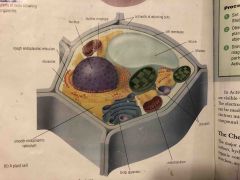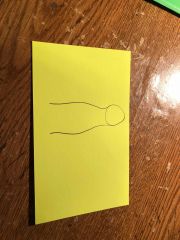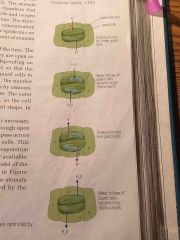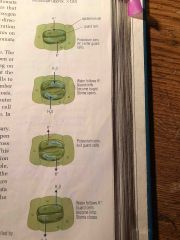![]()
![]()
![]()
Use LEFT and RIGHT arrow keys to navigate between flashcards;
Use UP and DOWN arrow keys to flip the card;
H to show hint;
A reads text to speech;
100 Cards in this Set
- Front
- Back
- 3rd side (hint)
|
Who invented the first microscope? How many lenses did it have? |
Hans and Zacharias Janssen invented the first microscope. It consisted of two lens an ocular lens (eyepiece) and an objective lens |
|
|
|
Define compound microscope? |
A microscope that uses more than one lens to magnify objects. |
|
|
|
Name two things Robert Hooke was famous for |
-he made a homemade microscope that used three lenses -he coined the term “cell” by observing thin slices of cork under a microscope, he thought it looked like prison cells |
|
|
|
What was Antoni van Leeuwenhoek famous for? |
He used a simple single-lens microscope like a magnifying glass to view different types of single cells. |
|
|
|
How do you calculate total magnification? |
Total Magnification = (ocular lens)(objective lens) |
|
|
|
What is spontaneous generation? |
The idea that life can emerge spontaneously from non-living matter? |
|
|
|
State the three points of cell theory |
- All living things are made up of one or more cells and the materials produced by these cells - All life functions take place in cells, making them the smallest unit of life - All cells are produced from pre-existing cells through the process of cell division |
|
|
|
Define contrast |
The ability to see the differences between structures due to differences in their capacity to absorb light. |
|
|
|
Define Resolution/resolving power |
The ability to distinguish between two structures that are very close together |
|
|
|
What is Fluorescence microscopy? |
A technique to localize substances in cells, by using the ability of those substances to fluoresce in the presence of ultraviolet light |
|
|
|
What is a confocal microscope? |
A confocal microscope uses light, laser beams and computers to produce 3D images from a combination of many perfectly-focused thin sections |
|
|
|
How does an electron microscope work? |
It uses a beam of electrons instead of a light wave and is able to produce images that provide fine detail. The image is formed by the absorption or scattering of the electron beam, because electron dense materials do not let electrons pass through. |
|
|
|
State the organization of life, including units of matter, from smallest to largest |
} = units of matter ] = units of life Atoms} Molecules } Organelles } Cells (basic unit of life)] Tissues] Organs] Systems] Organisms] |
|
|
|
What is the function of the cell membrane? |
Allows the transport if needed materials into the cell and waste materials out; protects the cell from its surroundings |
|
|
|
What is the function of the nucleus? |
Stores DNA Coordinates all cell activities Surrounded by nuclear envelope which has pores to slow the transport of materials |
|
|
|
What is the function of cytoplasm? |
Contains nutrients required by cell to carry on life processes Organelles are suspended in it, allows them to move |
|
|
|
What is the function of a cell wall? |
Rigid frame that provides strength and support |
|
|
|
What is the function of centrioles? |
Helps with cell division in animal cells |
|
|
|
What is the function of chloroplasts? |
Converts the light energy into sugars that can be used by cells |
|
|
|
What are vacuoles and vesicles? |
Storage area for nutrients and water, vesicles are a smaller version of vacuoles |
|
|
|
What is the function of the endoplasmic reticulum? |
It is a series of interconnected small tubes. It synthesizes, folds, modified and transports proteins |
|
|
|
What are ribosomes? |
Makes protein |
|
|
|
What are the two types of electron microscopes? Give a brief description of each of them |
- Transmission Electron Microscope(TEM) depends on a beam of electrons passes through a thin section of fixed and stained tissue, the electrons that pass through the specimen fall on a fluorescent screen or film and black and white photos are produced. It is hard to produce a 3D image from very thin sections. Also staining kills the specimen. -Scanning Electron Microscope(SEM) gives info on the surface features of a specimen. |
|
|
|
Plant cell |
Defend against invading bacteria, help removes damaged cell organelles. Contains digestive enzymes |
|
|
|
Animal cell |
Flat, dis-shaped sacs. Responsible for transporting, modifying, as packaging proteins and lipids into vesicles for delivery to targeted destinations. |
|
|
|
What is chromatin? |
DNA(deoxyribonucleic acid), it is the information for shape and function of the whole cell. Chromatin is short for chromosomes. |
|
|
|
What is the function of centrioles? |
Helps with cell division in animal cells, and move chromosomes around during cell division |
|
|
|
Describe a phospholipid |
The top is the phosphate “head” , it is hydrophilic(water-loving). The bottom is called the fatty acid “tail”, it is hydrophobic(water-fearing) |
|
|
|
What is gene mapping? |
A technique used to locate the position of specific genes within the genetic makeup of an organism |
|
|
|
What does the structure of DNA allow it to do? |
It enables it to direct all other activities in a cell |
|
|
|
What is an open system? |
Is one that must interact with its environment to maintain its existence |
|
|
|
Plant cell |

Defend against invading bacteria, help removes damaged cell organelles. Contains digestive enzymes |
|
|

Animal cell |
Flat, dis-shaped sacs. Responsible for transporting, modifying, as packaging proteins and lipids into vesicles for delivery to targeted destinations. |
|
|
|
What are all the life processes of a cell? |
-intake of nutrients -movement -growth -response to stimuli -exchange of gases -waste removal -reproduction |
|
|
|
What are the characteristics of life? |
-must be made up of cells -must be able to metabolize -must react to stimuli -must be able to adapt -must be able to grow -must maintain homeostasis -must be able to reproduce |
|
|

Describe a phospholipid |
The top is the phosphate “head” , it is hydrophilic(water-loving). The bottom is called the fatty acid “tail”, it is hydrophobic(water-fearing) |
|
|
|
Explain the cell membrane aka Phospholipid bilayer |
It is responsible for cell communication, transport of materials, and receiving messages. Proteins within the bilayer... -some run through them -some are attached outside -some are attached inside -some have sugars attached |
|
|
|
Explain the difference between Isotonic, Hypertonic and Hypotonic |
Hypertonic: concentration of solute is higher than compared solution Hypotonic: concentration of solute is lower than compared solution Isotonic: concentration of both solutions is equal |
|
|
|
Explain in which solutions a cell would be considered normal, shrinking, and bursting |
A cell is considered normal when it is in an isotonic solution A cell is considered shrinking when it is a hypertonic solution, which cause it to release some of its water to equalize the amount of concentration in and out of the cell A cell is considered bursting when it is in a hypotonic solution, which cause it to take in the water to balance the amount of concentration in and out of the cell |
|
|
|
What is facilitated diffusion? What kind of transport is it? |
Protein facilitators in a cell membrane help molecules move down a concentration gradient(specifically for molecules that are selectively not permeable but are necessary), it allows for charged particles and water soluble molecules to pass through -channel proteins act as both an entrance and exit(kind of like a tunnel) through the cell -carrier proteins act as a gateway (it opens at one end to let the molecules enter, then closes and opens on the other end it let it exit) |
|
|
|
Explain active transport |
Uses carrier proteins to pump molecules against the concentration gradient -requires energy in the form of ATP |
|
|
|
What is the difference between Endocytosis and Exocytosis? |
Endocytosis: the transport of materials into the cell using vesicles (cell membrane folds around material on it surface to form a vesicles which it brings into the cell) Exocytosis: the transport of materials out of the cell using vesicles(vesicles fuse to the cell membrane and merge to it, releasing its contents out of the cell |
|
|
|
What are membrane technologies? |
Industrial use of synthetics into mimic the action of membranes |
|
|
|
What are recognition proteins? |
Protein molecules protruding from cells that allow communication between cells, such as in sperm-egg recognition in a species |
|
|
|
What are receptor proteins? |
Specialized molecules on the surface of the cell to which messenger molecules on the surface of the cell can bind |
|
|
|
What are liposomes? |
Fluid-filled says surrounded by a phospholipid bilayer identical to the cell membrane of human cells; can be incorporated into living cells, and are used to transport medication into diseased cells without affecting normal cells, and to insert DNA in gene therapy |
|
|
|
Define Insulin |
A protein produced in the pancreas to regulate sugar levels |
|
|
|
State the particle model of matter |
1. All matter is made of particles 2. Particles are in constant motion 3. Particles are attracted to one another or bonded together 4. All particles have spaces between them |
|
|
|
Define hormone |
Chemical compound that travels from its production site in an organism to other sites where it produces an effect |
|
|
|
What is the difference between peritoneal dialysis and hemodialysis? |
Both are based on the principals of diffusion and osmosis Dialysis- rids the blood of wastes, toxins, and excess fluid produced by cells Peritoneal Dialysis takes place inside the body while hemodialysis requires blood to be removed from the body then cleaned |
|
|
|
Define Reverse Osmosis |
The movement of water through a semi-permeable membrane from a high concentration to of solute to a low concentration of solute(hypertonic to hypotonic) |
|
|
|
Define Desalination |
The removal of salt from a solution |
|
|
|
Explain the Surface area to volume ratio |
Cells and organisms are designed to have the largest surface area to volume ratio, to maximize the amount of nutrients it can take in. If a cell becomes larger it’s volume increases. To maximize efficiency and promote survival, an organism must have a great SA to volume ratio(creates lots of opportunities for transport of substances to occur) |
|
|
|
What are the four major organic compounds that make up the structure of cells? |
Lipids(fats/oils), carbohydrates(sugars, starches, cellulose), protein(muscle fibre), and nucleic acid(DNA$ |
|
|
|
What are the advantages and disadvantages of multicellular and unicellular organisms? |
Advantages: -Size -Division of labour -Interdependence Disadvantage: /is one cell functions abnormally it could affect the entire organism |
|
|
|
Explain the connection between cells, tissues, organs and organ systems |
Cells performing the same function together form tissues, tissues contributing to the same function form organs, organs that work together to form the same function form organ systems |
|
|
|
What are the two types of organ systems in a plant? Give a brief description of each |
1. Root system: -includes all tissues below ground -takes in water and minerals -transport of materials 2. Shoot system: Includes all tissue located above ground -stores food -gas exchange -photosynthesis(produces food) |
|
|
|
What are meristems? |
Plants increase their size from cell division in growth areas called meristems. |
|
|
|
What is the cytoskeleton? |
Network of fine protein fibres that supports cells that contain a nucleus. |
|
|
|
What are the three types of tissue in roots and shoot systems? |
Dermal tissue, ground tissue and vascular tissue |
|
|
|
What is dermal tissue? |
Epidermis(skin or outer layer) -exchange matter and gas into and out of the plant -protects the plant from disease -Waxy cuticle: waxy substance that resists attack from microorganisms and reduces water loss |
|
|
|
What is ground tissue? |
-underneath the epidermis -makes up majority of plant -stem: provides strength -roots: stores water and food -leaves: photosynthesis |
|
|
|
What is vascular tissue? |
Responsible for transport of material -xylem and phloem are bunched in vascular bundles |
|
|
|
What are the two types of tissue responsible for transportation of materials? Explain each of them |
1. Xylem Tissue: -brings water and minerals from the roots to the leaves -formed of dead cells creating a straw-like tube 2. Phloem Tissue: -brings carbohydrates(stores food){sugars} and water (turgor pressure) from the leaves to the other parts of the plant -sieve tube cells form the phloem. They have no nuclei, but they are connected to companion cells which direct their activity |
|
|
|
Give two examples of specialization in plants |
-Guard cells: cells that form small pores(stomata) in a leaf allowing gas exchange(dermal tissue) -root hairs: hair-like projections that increase the surface area for water and mineral absorption |
|
|
|
What is photosynthesis? |
-process of converting solar energy into chemical energy(energy from the sun I stored in the bonds of carbohydrates{glucose-sugar}) -occurs in chloroplasts in plant cells -reactants: CO2, H2O, light energy -products:C6H12O6(glucose), O2 -chlorophyll is the pigment in chloroplasts that absorb light and makes the plant appear green -photosynthesis occurs in in the presence of light |
|
|
|
What is Cellular respiration? |
-process of converting chemical energy in glucose into useable energy in the form of ATP -occurs in the mitochondria of cells -requires:C6H12O6, O2 -produces: CO2, H2O, energy(ATP) *reverse of photosynthesis |
|
|
|
Why are stomata usually round on the underside of the leaf? |
Because as water evaporates it rises. |
|
|
|
Define turgor pressure |
Pressure exerted against a cell wall by the water that has entered the cell through osmosis *imagine an inflated balloon with tape on the inside of one side |
|
|
|
Define concentration |
The amount of solute in a solution |
|
|
|
Explain the opening and closing of stomata |
Back (Definition) (Opening of stomata) 1.) -sunlight stimulates guard cells to actively transport K+ ions into cell -K+ ions concentration of guard cell increases(making the guard cell hypertonic to its surroundings) (Opening of stomata) 2.) - inner surface of cell wall in guard cell is thicker than outer wall -H20 moves into the guard cell by osmosis -turgor pressure in guard cells increases, cells bulge outward, stomata open (Closing of stomata) 3.) -when stomata are open, transpiration occurs -when excess water is lost, guard cell stop active transport of K+, K+ ions diffuse out of cells(making guard cells hypotonic to surrounding cells) (Closing Stomata) 4.) -H20 leaves guard cells by osmosis -turgor pressure decreases, stomata close |
|
|
|
Define Transpiration |
Evaporation if water |
|
|
|
Describe the relationship between transportation and the sensitivity of stomata |
Transpiration can lead to the drying out of the plant |
|
|
|
What are lenticels? |
-pores found on stems -create another pathway for gas exchange |
|
|
|
Why are stomata usually round on the underside of the leaf? |

Because as water evaporates it rises. |
|
|
|
What are vascular bundles? |
Provide leaf with water for transpiration and photosynthesis{xylem} -removes sugar produced in photosynthesis and transports to other parts of the plant{phloem} |
Bundles of xylem and phloem |
|
|
Explain the opening and closing of stomata |

Back (Definition) (Opening of stomata) 1.) -sunlight stimulates guard cells to actively transport K+ ions into cell -K+ ions concentration of guard cell increases(making the guard cell hypertonic to its surroundings) (Opening of stomata) 2.) - inner surface of cell wall in guard cell is thicker than outer wall -H20 moves into the guard cell by osmosis -turgor pressure in guard cells increases, cells bulge outward, stomata open (Closing of stomata) 3.) -when stomata are open, transpiration occurs -when excess water is lost, guard cell stop active transport of K+, K+ ions diffuse out of cells(making guard cells hypotonic to surrounding cells) (Closing Stomata) 4.) -H20 leaves guard cells by osmosis -turgor pressure decreases, stomata close |
|
|
|
Define root pressure |
Active transport in the roots uptake minerals to give hypotonic environment -water is drawn up into cells -water can only be drawn up a few meters |
|
|
|
Define Transpiration Pull |
Evaporation if water through stomata and lenticels create a pull to draw the water up the xylem -this happens in conjunction with adhesion, cohesion, and root pressure |
|
|
|
Describe how Transpiration and root pressure work together to transport water |
{Root Pressure} 1.) minerals in soil are actively transported into roots(roots become hypertonic) 2.) H2O is absorbed into roots by osmosis. Root pressure moves H2O up stem(a few meters) {Transpiration Pull} 3.) H2O evaporates and exits lead through stomata 4.) As H2O exits by transpiration, H2O is pulled up the xylem. H2O is supported in xylem by adhesion, and pulled by cohesion. |
|
|
|
Define concentration gradient |
The difference in concentration between two areas |
|
|
|
Define Turgid, And Flaccid |
Turgid: firm; plant cells become turgid when water enters due to a hypotonic environment Flaccid: drooping or inelastic due to lack of water |
|
|
|
What is plasmolysis? |
Shrinking of a plant cell due to hypertonic solution(causes wilting and drooping) |
|
|
|
Define source to sink |
Source: places where sugar is made(photosynthesis)(leaves) Sink:places where sugars are needed(for growth, repair, respiration) The phloem brings sugars from source to sink *this is done by the pressure flow theory |
|
|
|
What is the pressure flow theory? |
1.) At leaf: companion cells use active transport to take in sugar molecules from all chloroplasts 2.) Water moves into sieve cells by osmosis due to hypotonic environment 3.) Water pressure inside the cells pushes water to other parts of the plant |
|
|
|
What is a stimulus? |
Something that causes a response -plants respond to internal and external stimuli -plants need water, CO2, and light for photosynthesis-they respond to accommodate these needs |
|
|
|
What is phototropism? |
It is a plants response to the stimulus of light -stems exhibit positive phototropism(grows towards the light)-leaves-photosynthesis (leaves grow towards light for photosynthesis) -roots show a weak negative phototropism(grows away from light)-water/minerals-away from sun(where H2O is round) |
|
|
|
What is Gravitropism? |
Earth’s gravitational force •stems grow against gravity(negative gravitropism) •roots grow towards gravitational force(positive gravitropism) |
|
|
|
What did Charles And Francis discover during their experiment? |
They discovered that the tip of the plant was responsible for the detection of light |
|
|
|
What is the area of elongation? |
Phototropic response created by elongation of cells on the side of the leaf facing away from the light |
|
|
|
What is Auxin? |
A chemical that moves from the tip(that allows communication) |
|
|
|
Define selectively permeable membrane |
A membrane that allows some particles to pass through but not all |
|
|
|
What is The Mechanism of Gravitropism? |
-plants rely on heavy starch particles in specialized cells as an indicator of gravity -when the starch indicates the gravitational force, a growth response results |
|
|
|
What are other control mechanisms plants use? |
-plants attach to supports to aid growth(ex. Fence) -flowering of plants at particular times is a response to the length of darkness the plant is exposed to |
|
|
|
Define control systems |
Systems within a plant that produce definite responses to specific stimuli |
|
|
|
What is passive transport? |
Movement of substances from high concentration to low concentration *NO ENERGY IS REQUIRED |
|
|
|
What is active transport? |
Movement of substances from low concentration to high concentration -moves against the concentration gradient *REQUIRES ENERGY IN THE FORM OF ATP |
|
|
|
What is diffusion? |
The natural movement of particles down a concentration gradient (high to low) -results in equilibrium |
|
|
|
Define osmosis |
The diffusion of water through a selectively permeable membrane. It flows from a low solute concentration to a high solute concentration(hypotonic to hypertonic) |
|
|
|
What is pressure difference? |
The difference in pressure between two areas that may cause movement of substances |
|

